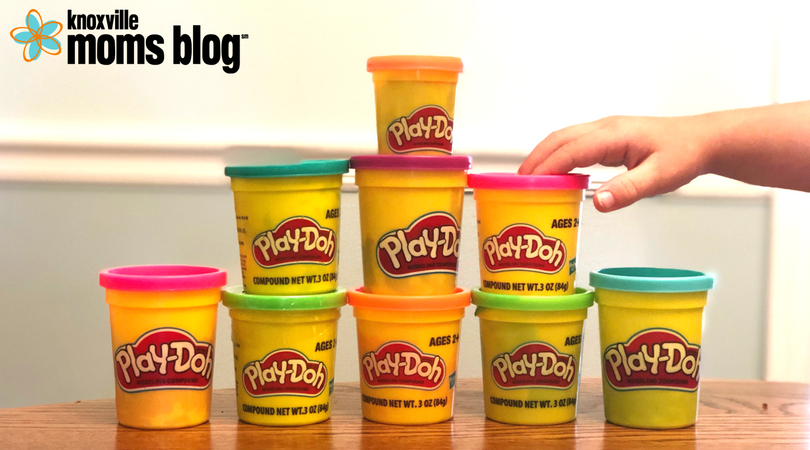Put the pitchfork down, and hear me out.
I know this is a controversial topic among moms. Mention Play-Doh around a group of mothers, and mob mentality quickly consumes them, each quick to share their hatred for the modeling compound. I once attended a birthday party in which the birthday kid’s mom rolled her eyes and sighed at every gifted box of Play-Doh. I get it. It’s messy. It requires a little more work than the average toy. Clean up is a whole thing.
But your kid needs to play with Play-Doh.
I have a few degrees in early childhood education and taught pre-K for a couple of years. I’ve endured my share of “Oh, so you play with Play-Doh all day” comments. Well, yes and no. We don’t play with Play-Doh all day, or even every day, but you bet with play with Play-Doh. When you calculate the cost-benefit ratio, how could you not play with Play-Doh?!
Here are a few outstanding benefits of Play-Doh:
1. Finger Strength
You can always tell which kids have experience with Play-Doh. Their finger strength, fine motor control, and hand-eye coordination immediately stands out compared to their Play-Doh-less friends. Why is this important? Handwriting. Play-Doh kids write more clearly and for a longer duration without their hands tiring. Yes, the other kids eventually catch up, but in today’s world of fast-paced kindergarten, time is already lost. If your child is struggling with handwriting, a prescription of Play-Doh time may be just what the doctor occupational therapist orders. Of course, there are extenuating circumstances that inhibit some children’s fine motor development, but for the typically-developing child, Play-Doh strengthens those muscles like no other.
2. Stress Relief
This one applies to kids and grown ups. The stress-ball effect of Play-Doh helps children regulate their emotions and calm down during especially difficult moments. Many schools include Play-Doh in their “calming down corners” for this reason. And moms, I’m living proof that it works on grown ups, too. When my kids and I are on each other’s ever-loving nerves, we pull out Play-Doh, squeeze out our frustration, and talk it out.
3. Creativity
Kids aren’t aware they’re building finger strength, but they’re totally aware of the creative possibilities of Play-Doh. This creative outlet allows them to flex their artistic muscles, building worlds and creatures and exploring their imaginative mind. The 3-D aspect of Play-Doh is especially important as children begin to understand properties of solid shapes, a skill they will need in math and science.
4. Color Identification
For younger children, Play-Doh is a great informal tool to teach colors. As you play, talk about which color you’re using. Encourage children to ask for a specific color. Try to use the correct colors to build Play-Doh trees, basketballs, and flowers.
5. The Perfect Re-occurring Gift
We love Play-Doh because it’s relatively inexpensive and comes in so many different forms. Single canisters, color packs, glitter Play-Doh, themed sets — it all makes perfect gifts. For the family member that doesn’t know what to buy your kids, Play-Doh can be given multiple times a year and never get old. Not sure what to get the birthday boy or girl? Play-Doh is perfect for all ages, genders, and interests.
I know it’s messy. When I mention Play-Doh to friends, they usually dive into a list of complaints that all revolve around cleaning. We have a few general rules in our house that allows us to play without stress. We only use Play-Doh at our kitchen table. We play right on the table, but you can buy cheap cookie sheets as Play-Doh trays. Wax paper taped on the table also works, too. We keep our Play-Doh in a cabinet out of reach so my kids don’t get into it on their own. A Rubbermaid tub is great for storing the canisters and all the tools. We try to keep the themed sets together in the original box, but it’s really not the end of the world if things get mixed up.
Mixed-up colors are a huge stressor for a lot of moms. This is important: IT’S FINE IF THEY GET MIXED UP. For a while, I tried to institute a one-color-at-a-time rule to avoid the mixed colors, but I spent all my time opening canisters that it wasn’t fun for anyone. Imagine my shock when I learned that my kids DID NOT CARE if the Play-Doh was a strange shade of gray/brown. They played with it just the same. As they’ve gotten older, we’ve been able to incorporate more responsibility-taking skills into our Play-Doh play. If they really love one shade of Play-Doh, they must be careful not to mix it. They’ve also learned they have to clean it up quickly when they’re done to avoid drying out.






















